Medieval Rulership and Assembly: Thoughts on ‘Practice, Power and Place’ and ‘Residence, Ritual and Rulership’
IF 1.1
3区 历史学
0 ARCHAEOLOGY
引用次数: 0
Abstract
The two articles under discussion contain new and important considerations of the enacting of rulership in the Early Middle Ages. Both papers, although firmly based on detailed archaeological discussions of specific sites in southern Britain and Ireland respectively, make use of comparisons with other geographical areas, such as Scandinavia. Patrick Gleeson’s request that such comparative work should include both ‘Germanic and Celtic’ areas may seem obvious, but it is the case that Ireland as well as Scotland are frequently left out of discussions focusing on north-west Europe. A similar case was indeed made recently by authors in the volume Scotland in Early Medieval Europe (Blackwell 2019). By examining evidence from wider geographical areas, we have the potential to create overarching and conceptual discussions that in turn generate new pathways of thinking. In this piece, I intend to build on this approach and offer commentary from a Scandinavian point of view on the links between rulership, royal estates, and assembly sites, which are some of the main themes emerging from the two papers. Gabor Thomas and Chris Scull draw parallels between the great hall complexes of southern Britain and the central place complexes of Scandinavia, both of which are seen to have been multipurpose, with assembly as one of the functions (cf. Brink 1996, p. 238). Gleeson, on the other hand, examines the links between Irish royal residences and outdoor assemblies and inauguration sites. In order to take the discussion further, it is important to consider what types of assembly are envisaged in the two articles. In this context there are two main types that need to be distinguished as they differed in terms of ritual, performance, and space; the public assembly (i.e. the Scandinavian thing, Old Norse þing) and the royal assembly (‘the council’, Old Norse ráð, Anglo-Saxon witan). In modern terms, the public assembly has been compared to parliaments and courts while the councils have been likened to ‘pre-meetings’ before the full parliamentary debates (Norr and Sanmark 2008, pp. 379–381). The thing, also referred to as the ‘open assembly’, was elite led and participation was above all limited to landowners, although the overriding principle was that everyone was welcome, perhaps even encouraged, to attend. Thing meetings were held at outdoor assembly sites, many of which have been identified across Scandinavia (Norr and Sanmark 2008, pp. 379–381, Semple et al. 2020, chs. 4, 5 and 8). A major reason why meetings were held outdoors was the ‘concept of public knowledge’, seen as the ‘foundation of early Scandinavian law’ (Stein-Wilkeshuis 1998, pp. 313–314). The existence of this concept中世纪统治与议会:关于“实践、权力与场所”与“居住、仪式与统治”的思考
正在讨论的两篇文章包含了中世纪早期制定统治的新的和重要的考虑。尽管这两篇论文都坚定地建立在对英国南部和爱尔兰各自特定地点的详细考古讨论的基础上,但它们都利用了与其他地理区域(如斯堪的纳维亚半岛)的比较。帕特里克·格里森(Patrick Gleeson)要求这种比较工作应该包括“日耳曼和凯尔特”地区,这似乎是显而易见的,但事实是,爱尔兰和苏格兰经常被排除在关注西北欧的讨论之外。最近,作者在《中世纪早期的苏格兰》(Blackwell 2019)一书中确实提出了类似的案例。通过研究来自更广泛地理区域的证据,我们有可能开展全面和概念性的讨论,从而产生新的思维途径。在这篇文章中,我打算以这种方法为基础,从斯堪的纳维亚人的角度对统治、王室地产和集会地点之间的联系进行评论,这是两篇论文中出现的一些主要主题。Gabor Thomas和Chris Scull将英国南部的大厅建筑群和斯堪的纳维亚半岛的中心建筑群进行了比较,两者都被认为是多用途的,集会是其中一种功能(参见Brink 1996, p. 238)。另一方面,格里森考察了爱尔兰王室住宅与户外集会和就职场所之间的联系。为了进一步进行讨论,重要的是要考虑这两条中设想了何种类型的大会。在这种情况下,有两种主要类型需要区分,因为它们在仪式,表演和空间方面有所不同;公众大会(即斯堪的纳维亚的东西,古挪威语的“þing”)和皇家大会(“council”,古挪威语ráð,盎格鲁撒克逊人的“witan”)。用现代术语来说,公众大会被比作议会和法院,而理事会被比作议会全面辩论之前的“预会”(Norr and Sanmark 2008, pp. 379-381)。这也被称为"公开大会"由精英领导,只有地主才能参加,但最重要的原则是,欢迎甚至鼓励所有人参加。Thing会议在户外组装地点举行,其中许多已经在斯堪的纳维亚半岛被确定(Norr和Sanmark 2008, pp. 379-381, Semple等人。2020,第1页)。会议在室外举行的一个主要原因是“公共知识的概念”,被视为“早期斯堪的纳维亚法律的基础”(Stein-Wilkeshuis 1998, pp. 313-314)。这个概念的存在
本文章由计算机程序翻译,如有差异,请以英文原文为准。
求助全文
约1分钟内获得全文
求助全文
来源期刊

Norwegian Archaeological Review
ARCHAEOLOGY-
CiteScore
2.10
自引率
0.00%
发文量
13
期刊介绍:
Norwegian Archaeological Review published since 1968, aims to be an interface between archaeological research in the Nordic countries and global archaeological trends, a meeting ground for current discussion of theoretical and methodical problems on an international scientific level. The main focus is on the European area, but discussions based upon results from other parts of the world are also welcomed. The comments of specialists, along with the author"s reply, are given as an addendum to selected articles. The Journal is also receptive to uninvited opinions and comments on a wider scope of archaeological themes, e.g. articles in Norwegian Archaeological Review or other journals, monographies, conferences.
 求助内容:
求助内容: 应助结果提醒方式:
应助结果提醒方式:


